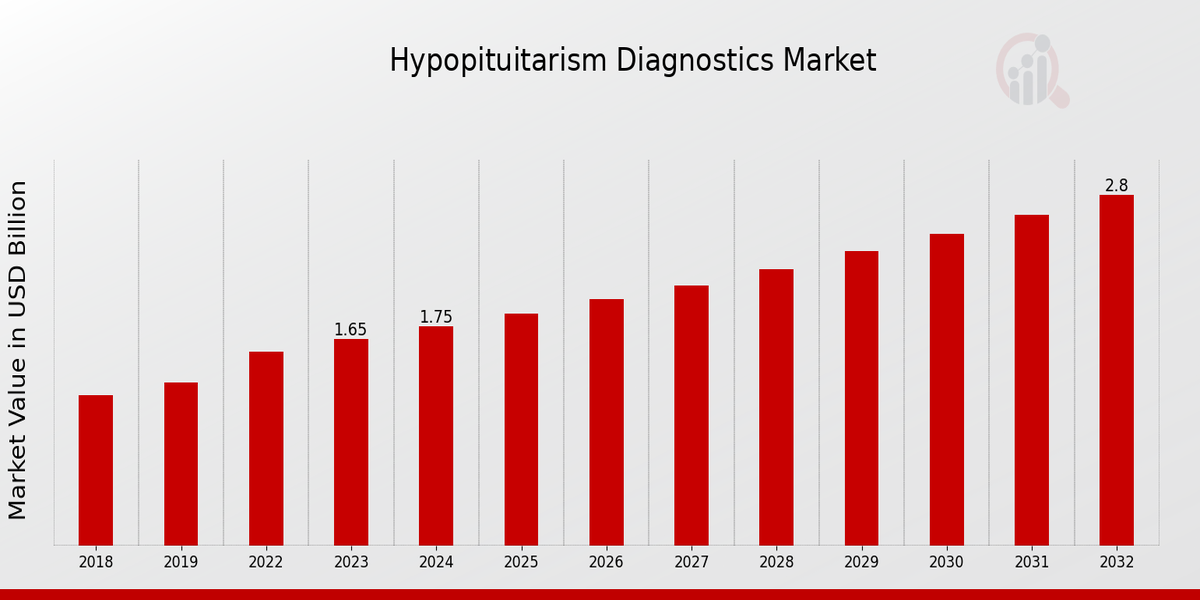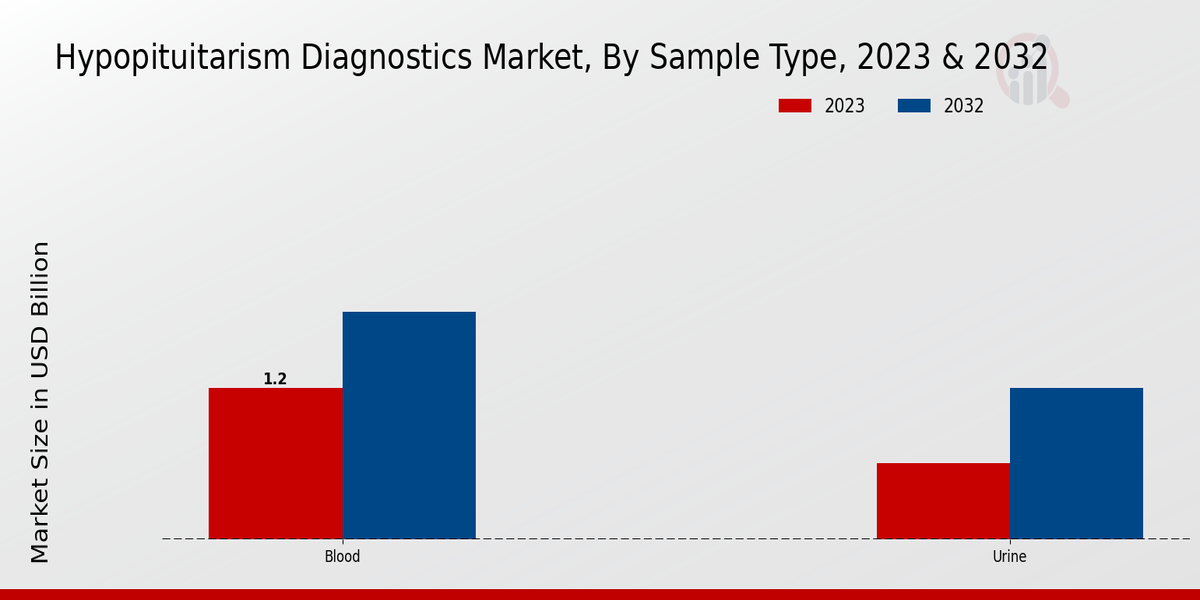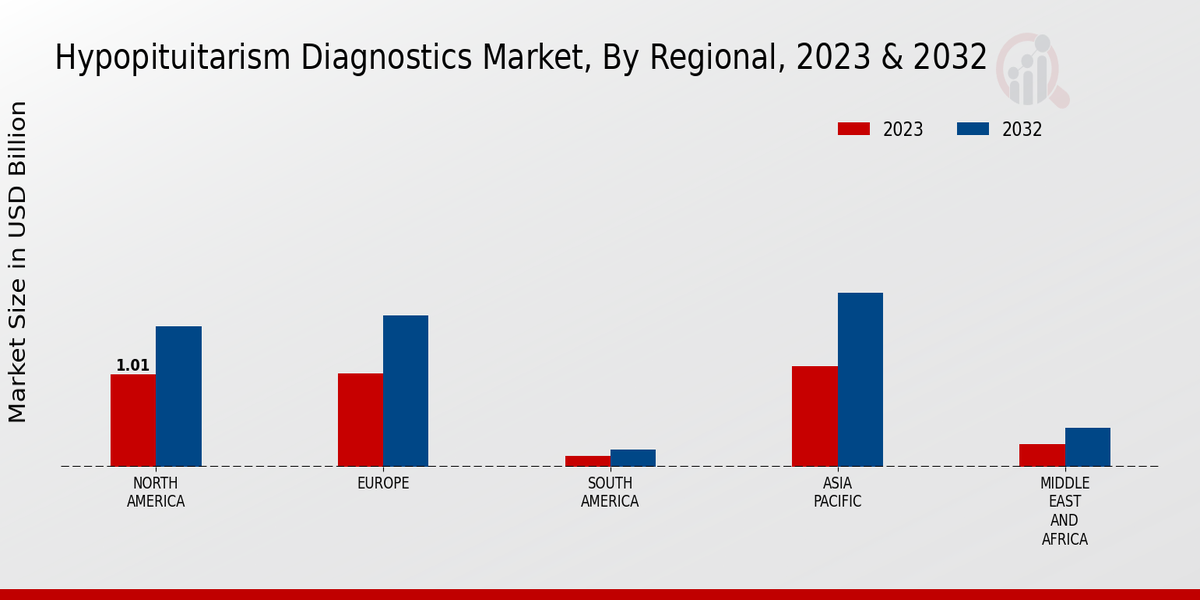Hypopituitarism Diagnostics Market Overview
As per MRFR analysis, the Hypopituitarism Diagnostics Market Size was estimated at 1.55 (USD Billion) in 2022.The Hypopituitarism Diagnostics Market Industry is expected to grow from 1.65(USD Billion) in 2023 to 2.8 (USD Billion) by 2032. The Hypopituitarism Diagnostics Market CAGR (growth rate) is expected to be around 6.08% during the forecast period (2024 - 2032).
Key Hypopituitarism Diagnostics Market Trends Highlighted
Hypopituitarism diagnostics market is likely to witness an upward growth trajectory due to advanced technologies which are likely to increase both the efficiency and accuracy of the procedures. The introduction of sensitive and specific assays, such as chemiluminescent immunoassays and multiplex immunoassays, enables particular measurement of pituitary hormones thereby enhancing the chances of recognizing and supervising hypopituitarism more effectively
New market potentials are in the provision of POCT and home based test kits for the condition of hypopituitarism. Such inventions give idea for easy and convenient diagnostic intervention so as to perform the procedures in a quick manner that saves the cost of health care advanced services.
Latest trends in the market include the integration of artificial intelligence (AI) and machine learning (ML) into diagnostic tools. AI algorithms aid in analyzing complex data, improving diagnostic accuracy and efficiency. Additionally, technological advancements in imaging techniques, such as MRI and CT scans, provide detailed anatomical visualization of the pituitary gland, assisting in diagnosis and differential diagnosis.

Source: Primary Research, Secondary Research, MRFR Database and Analyst Review
Hypopituitarism Diagnostics Market Drivers
Increasing Prevalence of Endocrine Disorders
The increasing number of endocrine disorders, including hypopituitarism, are the main drivers of the global hypopituitarism diagnostics market. Obesity, diabetes and environmental pollution highlight the rise of the above-mentioned diseases, which leads to a constantly growing need for the given service ensuring accurate and timely diagnosis. Moreover, the constantly expanding awareness about hypopituitarism and its symptoms among healthcare employees and the population also contributes to market growth.
Technological Advancements in Diagnostic Methods
Global Hypopituitarism Diagnostics Market Industry is transformed due to the rapid growth in diagnostic technologies. More sensitive and specific assays such as chemiluminescence immunoassays and electrochemiluminescence immunoassays have been developed to overcome the challenges in the hypopituitarism diagnosis process. In addition to the previously developed technology, molecular testing technology has also been adopted and it has enabled the recognition of implicated genetic mutations in the condition.
Growing Geriatric Population
The hypopituitarism diagnostics market is also significantly influenced by the aging population. Elderly individuals are more likely to suffer from endocrine disorders, including hypopituitarism. The rise in the prevalence of hypopituitarism among the aging population can be attributed to the age-related changes in the pituitary gland and the hypothalamus, leading to an increased need for diagnostic tests and monitoring.
Hypopituitarism Diagnostics Market Segment Insights
Hypopituitarism Diagnostics Market Sample Type Insights
The Global Hypopituitarism Diagnostics Market is segmented by Sample Type into Blood and Urine. Among these segments, the Blood segment is expected to hold the largest market share in 2023 and is projected to continue its dominance throughout the forecast period. The Blood segment accounted for approximately 60% of the Global Hypopituitarism Diagnostics Market revenue in 2023 and is expected to reach a value of $1.2 billion by 2032, growing at a CAGR of 6.3%. The growth of this segment is attributed to the increasing adoption of blood tests for the diagnosis of hypopituitarism.Blood tests can provide accurate and reliable information about hormone levels, which is essential for diagnosing hypopituitarism. The Urine segment is expected to grow at a CAGR of 5.8% during the forecast period and is projected to reach a value of $0.6 billion by 2032. The growth of this segment is attributed to the increasing use of urine tests for the diagnosis of hypopituitarism. The growth of the market is attributed to the increasing prevalence of hypopituitarism, the growing adoption of diagnostic tests, and the advancements in technology.

Source: Primary Research, Secondary Research, MRFR Database and Analyst Review
Hypopituitarism Diagnostics Market Technology Insights
The Market is segmented by Technology into Immunoassays, Chromatography, and Molecular Diagnostics. Immunoassays occupied the highest market share in 2023. The high share of the segment is attributed to the high accuracy and sensitivity of immunoassays in the detection of pituitary hormones. The Molecular Diagnostics segment is expected to be the fastest-growing segment during the forecast period. The growth of the segment can be attributed to recent advancements in genetic testing technologies and the increasing use of personalized medicine by the patients.The Chromatography segment is also expected to occupy a considerable market share due to the high-performance separation and detection of pituitary hormones by chromatographic techniques, thereby useful for research and clinical applications.
Hypopituitarism Diagnostics Market Disease Type Insights
The Disease Type segment of the Global Hypopituitarism Diagnostics Market is categorized into Pituitary Adenomas, Craniopharyngiomas, Genetic Disorders, and Traumatic Brain Injury. Pituitary Adenomas account for the largest share of the market, due to their high prevalence and the availability of advanced diagnostic techniques for their detection. Craniopharyngiomas, a type of brain tumor, also contribute significantly to market growth. Genetic Disorders, such as Kallmann syndrome and CHARGE syndrome, are another major driver of the market, as they can lead to hypopituitarism and require specialized diagnostic tests.Traumatic Brain Injury (TBI) is an emerging segment in the market, as it can cause damage to the pituitary gland and result in hypopituitarism. The Global Hypopituitarism Diagnostics Market revenue is expected to reach USD 1.85 billion in 2024, with a CAGR of 6.5%.
Hypopituitarism Diagnostics Market Diagnostic Approach Insights
The Global Hypopituitarism Diagnostics Market segmentation by Diagnostic Approach comprises 'Initial Screening', 'Confirmatory Diagnosis', and 'Monitoring'. Initial screening involves assessing symptoms, medical history, and physical examinations to identify potential hypopituitarism cases. In 2024, the global hypopituitarism diagnostics market revenue from initial screening is projected to reach USD 850 million, exhibiting a CAGR of 6.5% during the forecast period. Confirmatory diagnosis utilizes specialized tests, such as hormone level measurements and imaging techniques, to confirm the diagnosis.This segment is expected to contribute USD 1.2 billion to the market in 2024, growing at a CAGR of 6.2%. Monitoring involves ongoing assessments to track disease progression and treatment response, representing a significant market segment with a projected revenue of USD 1.1 billion in 2024 and a CAGR of 6.3%.
Hypopituitarism Diagnostics Market End-User Insights
The Global Hypopituitarism Diagnostics Market is segmented based on end-user into hospitals, diagnostic laboratories, and research institutes. Among these, hospitals are expected to account for the largest share of the market in 2023, owing to the increasing number of patients suffering from hypopituitarism and the rising demand for advanced diagnostic procedures. Diagnostic laboratories are also expected to witness a significant growth rate during the forecast period, due to the increasing adoption of molecular and genetic testing for hypopituitarism diagnosis.Research institutes are expected to contribute a smaller share to the market, but they are likely to play a crucial role in the development of new diagnostic methods and technologies for hypopituitarism. The Global Hypopituitarism Diagnostics Market is expected to reach USD 2.8 Billion by 2032, exhibiting a CAGR of 6.08% during the forecast period.
Hypopituitarism Diagnostics Market Regional Insights
The Regional segment is an important part of the Global Hypopituitarism Diagnostics Market research report. It provides data on the market size, growth rate, and key trends in different regions around the world. According to the report, North America is expected to hold the largest share of the global market in 2024, followed by Europe and APAC. The market in North America is driven by the high prevalence of hypopituitarism and the increasing adoption of advanced diagnostic technologies. Europe is another major market for hypopituitarism diagnostics, with a large number of patients and a well-established healthcare system.The APAC market is expected to grow rapidly in the coming years, due to the rising incidence of hypopituitarism and the increasing awareness of the condition. South America and MEA are also expected to contribute to the growth of the global market, although they currently account for a smaller share.

Source: Primary Research, Secondary Research, MRFR Database and Analyst Review
Hypopituitarism Diagnostics Market Key Players and Competitive Insights
Major players in the Hypopituitarism Diagnostics Market industry are continuously focusing on developing new and innovative products to cater to the evolving needs of patients. Leading Hypopituitarism Diagnostics Market players are investing heavily in research and development to stay ahead of the competition. These companies are also expanding their global presence through strategic partnerships and acquisitions. The Hypopituitarism Diagnostics Market is expected to witness significant growth in the coming years, driven by factors such as increasing prevalence of hypopituitarism, growing awareness about the condition, and technological advancements. The competitive landscape of the Hypopituitarism Diagnostics Market is expected to remain intense, with major players vying for market share.One of the leading players in the Global Hypopituitarism Diagnostics Market is Roche Diagnostics. The company offers a comprehensive range of diagnostic tests for hypopituitarism, including blood tests, imaging tests, and genetic tests. Roche Diagnostics has a strong global presence and a well-established distribution network. The company is committed to providing high-quality diagnostic products and services to patients worldwide.Another major player in the Global Hypopituitarism Diagnostics Market is Siemens Healthineers. The company offers a wide range of diagnostic products and services for hypopituitarism, including laboratory tests, imaging tests, and point-of-care tests. Siemens Healthineers has a strong focus on innovation and is constantly developing new and improved diagnostic technologies. The company has a global presence and serves customers in over 100 countries.
Key Companies in the Hypopituitarism Diagnostics Market Include
Hypopituitarism Diagnostics Market Industry Developments
The global hypopituitarism diagnostics market is expected to grow from USD 1.85 billion in 2023 to USD 2.8 billion by 2032, at a CAGR of 6.08% during the forecast period. This growth is primarily attributed to the rising prevalence of hypopituitarism, increasing awareness about the condition, technological advancements in diagnostic techniques, and growing demand for personalized medicine. Furthermore, the increasing adoption of advanced imaging techniques such as MRI and CT scans, and the availability of genetic testing for hypopituitarism are expected to drive market growth over the forecast period. The market is also witnessing strategic collaborations and partnerships among market players to develop and commercialize innovative diagnostic solutions for hypopituitarism
Hypopituitarism Diagnostics Market Segmentation Insights
Hypopituitarism Diagnostics Market Sample Type Outlook
Hypopituitarism Diagnostics Market Technology Outlook
- Immunoassays
- Chromatography
- Molecular Diagnostics
Hypopituitarism Diagnostics Market Disease Type Outlook
- Pituitary Adenomas
- Craniopharyngiomas
- Genetic Disorders
- Traumatic Brain Injury
Hypopituitarism Diagnostics Market Diagnostic Approach Outlook
- Initial Screening
- Confirmatory Diagnosis
- Monitoring
Hypopituitarism Diagnostics Market End-User Outlook
- Hospitals
- Diagnostic Laboratories
- Research Institutes
Hypopituitarism Diagnostics Market Regional Outlook
- North America
- Europe
- South America
- Asia Pacific
- Middle East and Africa
Beta feature
| Report Attribute/Metric |
Details |
| Market Size 2022 |
1.55(USD Billion) |
| Market Size 2023 |
1.65(USD Billion) |
| Market Size 2032 |
2.8(USD Billion) |
| Compound Annual Growth Rate (CAGR) |
6.08% (2024 - 2032) |
| Report Coverage |
Revenue Forecast, Competitive Landscape, Growth Factors, and Trends |
| Base Year |
2023 |
| Market Forecast Period |
2024 - 2032 |
| Historical Data |
2019 - 2023 |
| Market Forecast Units |
USD Billion |
| Key Companies Profiled |
Merck KGaA, Randox Laboratories, Instrumentation Laboratory, Ortho Clinical Diagnostics, F. HoffmannLa Roche, Sysmex, DiaSorin, Thermo Fisher Scientific, Abbott Laboratories, Siemens Healthineers, Beckman Coulter, BioRad Laboratories, PerkinElmer, Danaher |
| Segments Covered |
Sample Type, Technology, Disease Type, Diagnostic Approach, End-User, Regional |
| Key Market Opportunities |
Increased awareness of hypopituitarism Technological advancements Growing geriatric population Expanding healthcare infrastructure Rise in research and development activities |
| Key Market Dynamics |
Increasing awareness Technological advancements Growing prevalence Diagnostic accuracy improvements Personalized medicine |
| Countries Covered |
North America, Europe, APAC, South America, MEA |
Frequently Asked Questions (FAQ) :
The Global Hypopituitarism Diagnostics Market is projected to reach 1.65 billion USD in 2023.
The Global Hypopituitarism Diagnostics Market is projected to reach 2.8 billion USD in 2032.
The Global Hypopituitarism Diagnostics Market is projected to grow at a CAGR of 6.08% from 2023 to 2032.
North America is expected to hold the largest market share in the Global Hypopituitarism Diagnostics Market in 2032.
The hospital segment is expected to hold the largest market share in the Global Hypopituitarism Diagnostics Market in 2032.
Key competitors in the Global Hypopituitarism Diagnostics Market include Abbott Laboratories, Beckman Coulter, bioMérieux, Diasorin, and F.
Key growth drivers of the Global Hypopituitarism Diagnostics Market include the increasing prevalence of hypopituitarism, the growing demand for accurate and timely diagnosis, and the development of new and innovative diagnostic technologies.
Key challenges facing the Global Hypopituitarism Diagnostics Market include the high cost of diagnostic tests, the lack of awareness about hypopituitarism, and the limited availability of specialized diagnostic centers in developing countries.
Key opportunities for the Global Hypopituitarism Diagnostics Market include the development of new and more affordable diagnostic tests, the increasing adoption of telemedicine, and the growing awareness about hypopituitarism.
Key trends in the Global Hypopituitarism Diagnostics Market include the increasing use of point-of-care testing, the development of non-invasive diagnostic methods, and the growing adoption of personalized medicine.

















